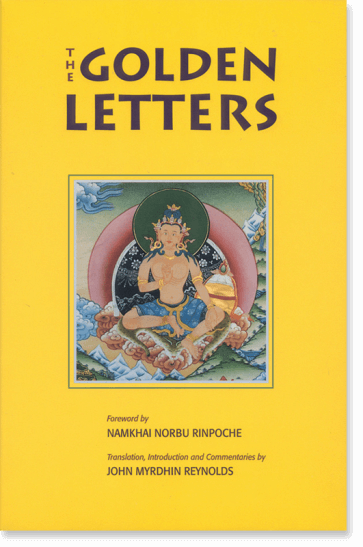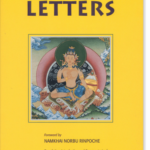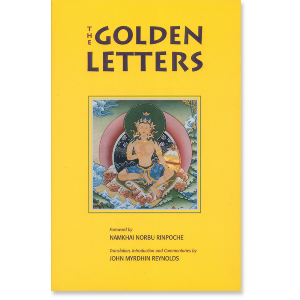| The following article is from the Summer, 1996 issue of the Snow Lion Newsletter and is for historical reference only. You can see this in context of the original newsletter here. |

trans. & ed. by John Reynolds foreword by Namkhai Norbu
Rinpoche 389 pp. #GOLE $18.95
Three Statements That Strike the Essential Path is an ancient Dzogchen revelation that introduces the practitioner to the nature of his or her own mind. One of the most immediately accessible commentaries, and one very widely known among Tibetan Dzogchen practitioners, is that of Patrul Rinpoche, the nineteenth-century Dzogchen master. Both this and one by H.H. Dudjom Rinpoche are included here. One of the main purposes of these texts is to provide the practitioner with a direct cognition of Dzogchen, the Primordial State.
The following is an excerpt from a section entitled The Special Teaching of the Wise and Glorious King.
Prologue
Homage to my benevolent Root Guru, he who possesses unequaled compassion. Here I shall explain a little of the method of practice associated with the essential points represented by the view, the meditation, and the conduct.
First, since my own Guru in his essence fully embodies and unifies within himself the totality of the Three Jewels, so by doing homage to him alone, one is actually paying homage to all of the sources of refuge simultaneously. Thus it says (in the root text): Homage to the Guru.
Moreover, as for the real meaning, which I shall explain here (regarding the following lines): If one practices wholeheartedly, having first become aware that all of one's Gurus, both one's own Root Guru as well as the Gurus belonging to all of the lineages of transmission which one has received, are, in fact, inseparable from one's own mind, then all threethe view, the meditation, and the conductare combined and included within the practice. Hence, I must explain here that the view, the meditation, and the conduct correspond precisely to the real meaning of the names of my own personal masters, both my Root Guru and the Gurus of my lineage of transmission.
First, the view is one's own awareness that all of the infinity of appearances occurring in both Samsara and Nirvana, however many there may be, are wholly perfected (from the very beginning) within the vast expanse of the Tathagatagarbha, which is the Dharmadhatu itself, free of all conceptual elaborations. Thus, since there exists an awareness of this real meaning, it says (in the root text): The view is Longchen Rabjampa (where this name literally means the infinite great vast expanse).
Then, with respect to this view, which in its own nature is free of all conceptual elaborations: (On the one hand, the view) is systematically established by means of discriminating wisdom (Skt. prajna) and insight (Skt. vipasyana) on the side of wisdom and emptiness. And then, (on the other hand,) it abides (and continues) evenly and one-pointedly in contemplation, where it is inseparably united with the skillful means of concentrated peaceful calm (Skt. Samatha), and therefore, (this represents the side) of great loving compassion. Since there exists here this meditation that links together both emptiness and compassion in this way, therefore it says in the text: The meditation is Khyentse Odzer (which literally means the light rays of wisdom and love).
Then, while in a state where one possesses equally such a view and such a meditation, one comes to practice wholeheartedly the six perfections for the benefit of others in accordance with the proper method of the Bodhisattvas, who represent the fresh sprouts (that will grow into) future Buddhas. Since this is the conduct and behavior (in question), it says in the text: The conduct is Gyalwe Nyugu (which literally means the fresh sprouts of future Buddhas).
The individual who practices wholeheartedly, having a view and a meditation and a conduct such as this, is described as one who truly possesses good fortune. Hence it says (in the root text): Anyone who practices wholeheartedly in this way....
And furthermore, having relied upon a secluded hermitage (as the site of retreat practice), if one is able to renounce the activities of this world and practice one-pointedly, then in this present life one will become liberated into the original Base, which has been primordially pure from the very beginning. Thus, it says in the text:... will surely attain Buddhahood within a single lifetime without striving after it.
Similarly, even though one may not accomplish this, still if one turns the mind toward a view, a meditation, and a conduct such as this, then, even in this present life, one will become aware of all negative conditions (being transformed, so as to) carry one farther along the path; and although remaining preoccupied with the activities of everyday life, one will not produce so many expectations and anxieties, while thereafter (in future rebirths) one will go from one happy existence to another. Hence, it says in the text: And even if one does not (accomplish the results of practice), one's mind will erjoy happiness. A-la-la!
The First Essential Point
Now I shall explain step by step the view, the meditation, and the conduct that possess such benefits as those (cited above). First, I want to explain extensively the method for practicing the view. Thus, it says in the text: As for the view of Longchen Rabjampa (the infinite great vast expanse).
Furthermore, by way of the actual secret instructions that pertain to these three statements that strike the essential points of the practice, one cuts off (at the root) the very vitality possessed by delusions. Hence, it says in the text: There are three statements that strike the actual essential points of the practice.
First there is the method for introducing the individual to the view that had not been introduced previously. In general, according to the Lakshanayana, one systematically establishes the view by means of various authoritative scriptural traditions and by reasoning. Again, according to the usual approach of the Secret Mantra system, having relied upon the knowledge of the example which is indicated during the third initiation, one is introduced to actual knowledge of primal awareness in the fourth initiation. There exist many systems for this. However, here the method of the Holy Gurus of the Siddha Lineage is to introduce directly (the nature of mind) by way of the dissolving of all mental activities.
Furthermore, at those times when the confused and turbulent waves of deluded thoughts (overwhelm the individual), gross discursive thoughts that pursue and follow after their objects will come to obscure the true face of the nature of mind. Thus, even though one has been introduced previously to it, one will not recognize (the nature of mind). For that reason, one must first allow those gross discursive thoughts (to settle down and the mind) to become clear. So, it says in the text: First, allow one's own mind to settle into a relaxed state....
Nevertheless, one's own mind, when it is allowed simply to settle down without making any attempt to
ξ
Table of Contents
Preface
Foreword by Namkhai Norbu Rinpoche
Introduction
The Primordial Origin of Dzogchen
The Place of Dzogchen in Buddhist Teaching
The Three Series of Dzogchen Teachings
PART ONE: The Three Statements That Strike the Essential Points
The Three Statements That Strike the Essential Points,
by Garab Doije
A Short Commentary on the Three Statements of
Garab Dorje, by H. H. Dui^jom Rinpoche
The Special Teaching of the Wise and Glorious King, The
Root Text and Auto-Commentary, by Patrul Rinpoche
Commentary on "The Special Teaching of the Wise and
Glorious King," by the Translator
The Last Testament of Garab Dorje
Interlinear Commentary to "The Last Testament of Garab
Dorje," by the Translator
PART TWO: The Life of Garab Dorje and Gum Sadhana
Translator's Introduction
The Life of Garab Dorje
Guru Sadhana for Garab Dorje, by Dzongsar Khyentse
Rinpoche
PART THREE: Historical Origins of Dzogchen
The Problems of Historiography
The Historical Existence of Garab Dorje
Possible Historical Sources of Dzogchen
Indian Buddhism
Ch'an Buddhism
Bon
Four Early Texts Relating to Dzogchen
Rig-pa'i khu-byug: The Earliest Dzogchen Text
Kun-byed rgyal-po: The Principal Dzogchen Tantra
bSam-gtan mig sgron: A Philosophical Exposition of Dzogchen
'Dra bag chen-mo: The Biography of Vairochana
Is Dzogchen an Authentic Buddhist Teaching?
The Primordial State of the Great Perfection
ξ
Note on the Translation of Dzogchen Technical Terms
Appendix: Brief Biography of Patrul Rinpoche
Glossary of Dzogchen Terms
Notes
Selected Bibliography
General Index
Index of Tibetan Texts and Terms


